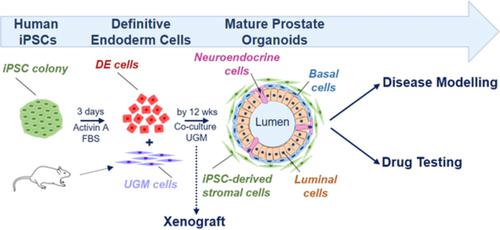当前位置:
X-MOL 学术
›
Stem Cells Transl. Med.
›
论文详情
Our official English website, www.x-mol.net, welcomes your
feedback! (Note: you will need to create a separate account there.)
Propagation of human prostate tissue from induced pluripotent stem cells.
STEM CELLS Translational Medicine ( IF 5.4 ) Pub Date : 2020-03-14 , DOI: 10.1002/sctm.19-0286 Anastasia C Hepburn 1 , Emma L Curry 1 , Mohammad Moad 1, 2 , Rebecca E Steele 3 , Omar E Franco 4 , Laura Wilson 1 , Parmveer Singh 1 , Adriana Buskin 1 , Susan E Crawford 4 , Luke Gaughan 1 , Ian G Mills 3, 5 , Simon W Hayward 4 , Craig N Robson 1 , Rakesh Heer 1, 6
STEM CELLS Translational Medicine ( IF 5.4 ) Pub Date : 2020-03-14 , DOI: 10.1002/sctm.19-0286 Anastasia C Hepburn 1 , Emma L Curry 1 , Mohammad Moad 1, 2 , Rebecca E Steele 3 , Omar E Franco 4 , Laura Wilson 1 , Parmveer Singh 1 , Adriana Buskin 1 , Susan E Crawford 4 , Luke Gaughan 1 , Ian G Mills 3, 5 , Simon W Hayward 4 , Craig N Robson 1 , Rakesh Heer 1, 6
Affiliation

|
Primary culture of human prostate organoids and patient‐derived xenografts is inefficient and has limited access to clinical tissues. This hampers their use for translational study to identify new treatments. To overcome this, we established a complementary approach where rapidly proliferating and easily handled induced pluripotent stem cells enabled the generation of human prostate tissue in vivo and in vitro. By using a coculture technique with inductive urogenital sinus mesenchyme, we comprehensively recapitulated in situ 3D prostate histology, and overcame limitations in the primary culture of human prostate stem, luminal and neuroendocrine cells, as well as the stromal microenvironment. This model now unlocks new opportunities to undertake translational studies of benign and malignant prostate disease.
中文翻译:

从诱导的多能干细胞中繁殖人类前列腺组织。
人前列腺类器官和患者来源的异种移植物的原代培养效率低下,无法进入临床组织。这阻碍了它们用于转化研究以发现新疗法的用途。为了克服这个问题,我们建立了一种补充方法,使快速增殖和易于处理的诱导多能干细胞能够在体内和体外产生人前列腺组织。通过使用与感应性泌尿生殖窦间质的共培养技术,我们全面概述了原位3D前列腺组织学,并克服了人类前列腺干,管腔和神经内分泌细胞以及基质微环境在原代培养中的局限性。该模型现在为进行良性和恶性前列腺疾病的转化研究带来了新的机遇。
更新日期:2020-03-14
中文翻译:

从诱导的多能干细胞中繁殖人类前列腺组织。
人前列腺类器官和患者来源的异种移植物的原代培养效率低下,无法进入临床组织。这阻碍了它们用于转化研究以发现新疗法的用途。为了克服这个问题,我们建立了一种补充方法,使快速增殖和易于处理的诱导多能干细胞能够在体内和体外产生人前列腺组织。通过使用与感应性泌尿生殖窦间质的共培养技术,我们全面概述了原位3D前列腺组织学,并克服了人类前列腺干,管腔和神经内分泌细胞以及基质微环境在原代培养中的局限性。该模型现在为进行良性和恶性前列腺疾病的转化研究带来了新的机遇。











































 京公网安备 11010802027423号
京公网安备 11010802027423号